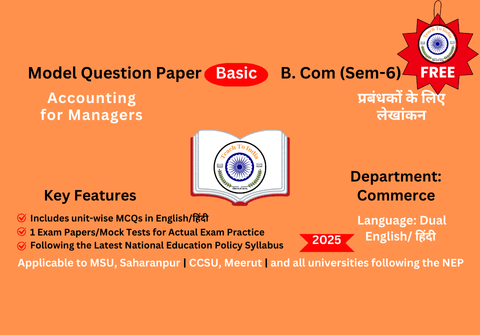Accounting for Managers - प्रबंधकों के लिए लेखांकन
- Description
- Curriculum
- Reviews

Model Question Paper
Accounting for Managers – प्रबंधकों के लिए लेखांकन
Key Features | मुख्य विशेषताएँ
- Bilingual Model Paper | द्विभाषी मॉडल पेपर
- Enough MCQ for Practice | अभ्यास के लिए पर्याप्त MCQ
- Exam Practice Paper with Mock Tests | मॉक टेस्ट के साथ परीक्षा अभ्यास पत्र
- Latest Syllabus as per NEP | NEP के अनुसार नवीनतम पाठ्यक्रम
- Designed by Experts | विशेषज्ञों द्वारा तैयार किया गया
The given MCQs cover only 10% of the syllabus | दिए गए बहुविकल्पीय प्रश्न केवल 10% पाठ्यक्रम को कवर करते हैं।
To cover 100% of the syllabus with summaries, upgrade to our Advanced Model Paper.| पूरा सिलेबस और सारांश कवर करने के लिए हमारा एडवांस मॉडल पेपर जॉइन करें। Join Advanced Model Paper
|
Program Class: Degree/ B.Com. |
Year: Third |
Semester: Sixth |
||
|
Subject: Commerce |
||||
|
Course Title: Accounting for Managers |
||||
|
Course Learning Outcomes: · After completing this course a student will have: · Ability to understand the concept of Managerial Accounting along with the basic forms and norms of Managerial Accounting. · Ability to understand the terminologies associated with the field of Managerial Accounting and control along with their relevance. · Ability to identify the appropriate method and techniques of Managerial Accounting for solving different problems. · Ability to apply basic Managerial Accounting principles to solve business and industry related issues and problems. · Ability to understand the concept of Budgetary Control, Cash Flow Statement, Fund Flow Statement, Break Even Analysis etc. |
||||
|
Credits: 5 |
Core Compulsory |
|||
|
Max. Marks: 25+75 |
Min. Passing Marks: 10+25 |
|||
|
Unit |
Topics |
|||
|
I |
Management Accounting- Concept, Meaning, Characteristics, Difference between Financial Accounting Management Accounting, Difference between Cost Accounting and Management Accounting, Techniques, Objectives and Importance. Management Accountant- Duties, Status, Functions and Responsibility. Financial Statement Analysis and Interpretation – Meaning, Objectives, Characteristics of an Ideal Financial Statement, Parties Interested in Financial Statement, Types of Financial Analysis – Horizontal, Vertical and Trend Analysis. |
|||
|
II |
Ratio Analysis: meaning, Utility, Classification of Ratios – Profitability Ratio, Activity Ratio and Financial Position Ratios. Fund Flow and Cash Flow Statement- Concept, Meaning of the term Fund and Preparation of Fund Flow Statement and Cash Flow Statement (As-3). |
|||
|
III |
Business Budgeting: Meaning of Budget and Budgeting, Objectives, Limitations and importance, Essentials of effective Budgeting, Classification of Budgets- Flexible budget and Zero Based Budget. Marginal Costing: Meaning, Determination of Profit under Marginal Costing, Pricing of Product, make or by Decision, Selection of most profitable channel. Break Even Analysis: Concept and Practical Applications of Break even Analysis. |
|||
|
IV |
Standard Costing and Variance Analysis: Meaning and Objectives of Standard Costing Setting of Standard, Variance Analysis: Material and Labour Variance. Reporting to Management: Meaning, Objectives, Principles of Reporting, Importance of Reports, Classification of Reports, Reporting at different Levels of Management. |
|||







